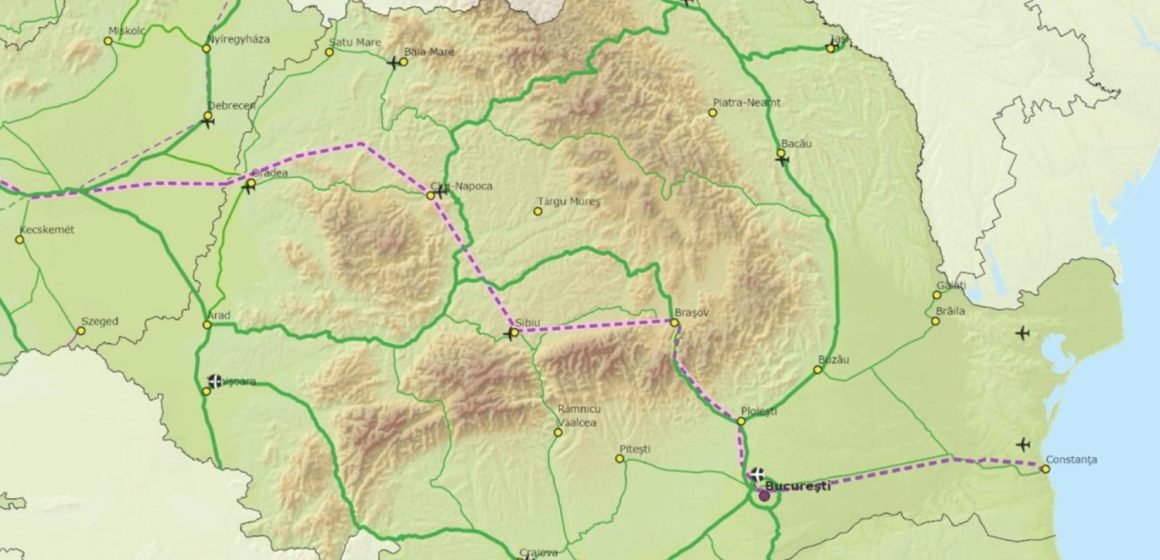Pe data de 5 decembrie 2021 publicam articolul România își propune ca până în 2030 să realizeze un Studiu de Fezabilitate pentru construcția unei linii de mare viteză Constanța – București – Budapesta. Vezi traseul propus. Scriam că Ministerul Transporturilor și Infrastructurii a pus în consultare publică un proiect de Hotărâre de Guvern privind aprobarea Planului Investițional pentru dezvoltarea infrastructurii de transport pentru perioada 2020-2030. Iar în cadrul acestui plan investițional este prins realizarea unui studiu de fezabilitate pentru tren de mare viteză.
Traseul propus este Constanța – București – Pitești – Curtea de Argeș – Sibiu – Mediaș – (Tg. Mureș) – Cluj-Napoca – Zalău – Oradea – Episcopia Bihor și legătura cu Budapesta.
Săptămâna aceasta, Comisia Europeană a publicat noile propuneri de transport cu privire la creșterea eficienței și sustenabilității mobilității. Pentru trenul de mare viteză, Comisia Europeană propune următorul traseu: Constanta – București – Brașov – Sibiu – Cluj-Napoca – Oradea și legătura cu Budapesta.
Principalele diferențe apar la porțiunile București – Sibiu și Sibiu – Cluj-Napoca. În propunearea României, Brașovul nu este inclus în traseul linei de mare viteză.
Iată ce spune Comisia Europeană:
„Main outcome/benefits of the TEN-T revision for Romania
1. Romania will be part of two corridors:
– The existing Rhine-Danube corridor will be reinforced. It will link Romania (including two ports on the Black Sea: Constanta and Sulina) to the economic centre of Europe in Germany (Frankfurt, Stuttgart). It will also link (which is not the case with the current Rhine-Danube) major ports on the Baltic and North Sea (Rostock, Hamburg, Bremen). This corridor is crossing Bulgaria, Hungary, Slovakia, Serbia, Austria, Czechia.
– A new North-South corridor is created at the Eastern flank of the EU: the Baltic-Black-Aegean Seas corridor, which will connect all Member States along the Eastern border of the EU. It will create a new connection between Poland (Gdynia/Gdansk), Slovakia, Hungary, Romania (including the port of Constanta), Bulgaria and Greece. This new corridor will link the Baltic, the Black Sea and the Aegean Sea.
2. The core network (road, rail, inland waterways) in Romania remains very stable. Romania should concentrate the available funding, in particular EU funding, on the completion of the core network (deadline 2030).
3. One objective of the TEN-T revision is to better link the Eastern part of the EU to the European high speed network. The new TEN-T network in Romania includes a high speed line that will link Romania (connecting Constanta, Bucarest, Brasov, Sibiu, Cluj-Napoca, Oradea) to the centre of Europe in Vienna (through Budapest).
In Romania the high speed line is included in the extended core network (deadline of completion 2040). To be noted that the stretch between Bucarest and Constanta is in the core network (deadline 2030). This line will include a tunnel of around 22 km south of Brasov, which will increase the efficiency of the whole line and which is part of the core network (deadline 2030).
4. Road and rail sections along the Western border of Romania will be upgraded from the comprehensive network (2050) to the extended core network (2040) because they are part of the newly created Baltic-Black-Aegean Seas corridor. This will contribute to accelerate the realisation of the TEN-T network in Romania.”




Leave a Reply